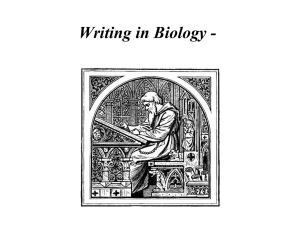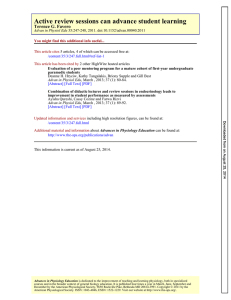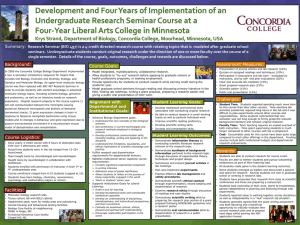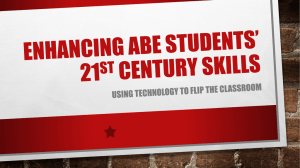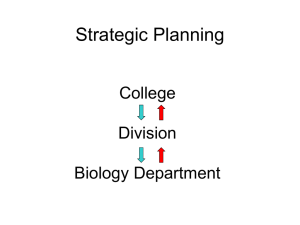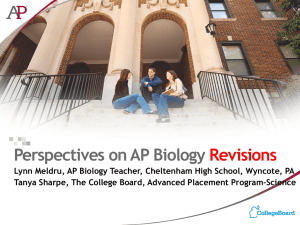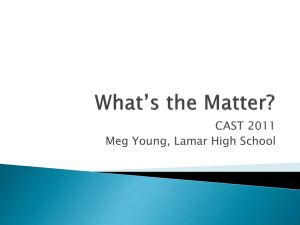Powerpoint presentation on V&C course transformation
advertisement
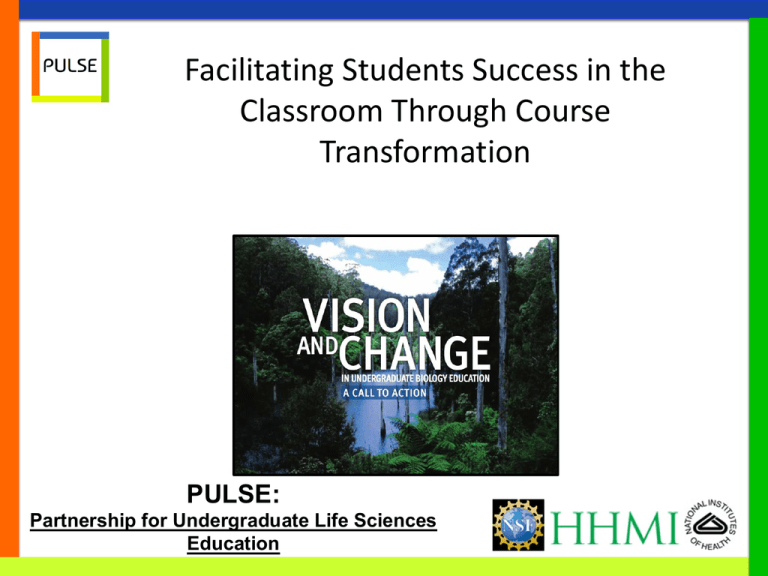
Facilitating Students Success in the Classroom Through Course Transformation PULSE: Partnership for Undergraduate Life Sciences Education Why Change? What’s the Urgency? STEM Pipeline --- Leaking Badly www.pulsecommunity.org Why Change? What’s the Urgency? Loss of students post-freshman Biology • 80% underrepresented • 60% for all others US needs 1 million new STEM degrees for the next decade to maintain global leadership (PCAST, 2012) 1 Trillion dollars (est) has been spent on educational reform with little full-scale change www.pulsecommunity.org Vision and Change Report (V&C) Focus on Faculty and Departments • Design Programs Based on Learning Outcomes • Innovative, Student-Centered Pedagogy • Integration of Authentic Research Experiences • Assessment of Student Success • Professional Development at All Institutional Levels • Resources and Tools www.pulsecommunity.org Implementation of V&C Core Concepts Competencies Inquiry-Based Learning Institutional Support Support for faculty development Faculty recognition Student engagement Infrastructure support National Biology Community Engagement www.pulsecommunity.org What is Active Learning? • The process of having students: – Engage – Reflect – Think – Problem solving Bloom's Six Levels of Understanding Traditional and Backward Design of STEM Courses Annual Reviews Examples of Active Learning Methods • • • • • Think-Pair-Share Two Minute Paper Student-generated test questions Problem-Based Learning (PBL) Process-oriented guided-inquiry learning (POGIL) • Flipped Classroom An Example Process-Oriented Guided-Inquiry Learning (POGIL) • POGIL is a classroom/laboratory technique that seeks to: – Teach content – Teach key process skills • Ability to think analytically • Work effectively as part of a collaborative team – Ensure all students are fully engaged in the learning process (Student-centered strategy). Mean final scores in the Anatomy and Physiology 2 (A&P 2) course from spring 2008 (SP08), fall 2008 (FA08), spring 2009 (SP09), and fall 2009 (FA09). Brown P J P Advan in Physiol Edu 2010;34:150-155 ©2010 by American Physiological Society Final exam grade distributions in A&P 2 from SP08, FA08, SP09, and FA09. Brown P J P Advan in Physiol Edu 2010;34:150-155 ©2010 by American Physiological Society A/B and D/F rates in A&P 2 from SP08, FA08, SP09, and FA09. Brown P J P Advan in Physiol Edu 2010;34:150-155 ©2010 by American Physiological Society Flipped Classroom Flipped Classroom • The flipped classroom is a pedagogical model in which the typical lecture and homework elements of a course are reversed. – For example, a short video lecture is viewed by students at home • In-class time is devoted to exercises, projects, or discussions. Flipped Classroom Students from disadvantaged backgrounds are at high risk for failure in introductory STEM courses. Highly structured course designs benefit all students, but especially disadvantaged students. For quarters with a common instructor, the achievement gap is halved with increased structure. Conclusions This study shows that a highly structured course design, based on daily and weekly practice with problem-solving, data analysis, and other higherorder cognitive skills, improved the performance of all students in a college-level introductory biology class and reduced the achievement gap between disadvantaged and nondisadvantaged students— without increased expenditures. References • Deslauriers, L., Schelew, E., and Wieman, C. (2011). Improved Learning in a Large-Enrollment Physics Class. Science 332, 862–864. • Freeman, S., O’Connor, E., Parks, J. W., Cunningham, M., Hurley, D., Haak, D., Dirks, C., and Wenderoth, M. P. (2007). Prescribed active learning increases performance in introductory biology. CBE—Life Sciences Education 6, 132. • Freeman, S., Haak, D., and Wenderoth, M. P. (2011). Increased course structure improves performance in introductory biology. CBE life sciences education 10, 175–86. • Haak, D. C., HilleRisLambers, J., Pitre, E., and Freeman, S. (2011). Increased Structure and Active Learning Reduce the Achievement Gap in Introductory Biology. Science 332, 1213–1216. • Lord, T. 2007. Society for College Science Teachers: Revisiting the Cone of Learning--Is it a Reliable Way to Link Instruction Method with Knowledge Recall? Journal of College Science Teaching. 37 (2): 14-17. • Michael, J. (2006). Where’s the evidence that active learning works? Advan. Physiol. Educ. 30, 159–167. • Prince, M. (2004). Does active learning work? A review of the research. J. Eng. Educ. 93, 223–231. • Wood, W. B. (2009). Innovations in teaching undergraduate biology and why we need them. Annual review of cell and developmental biology 25, 93–112.

